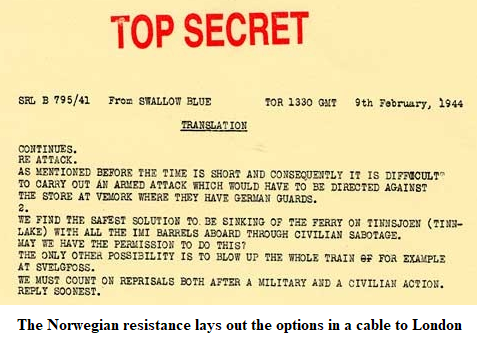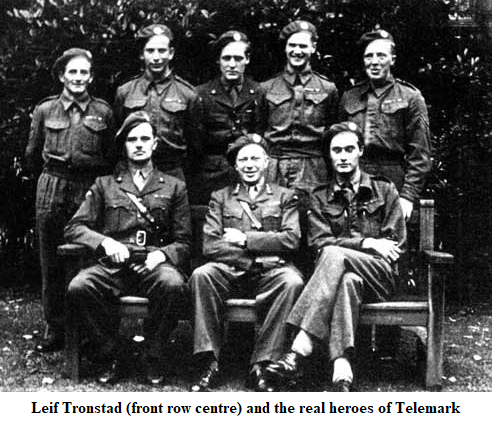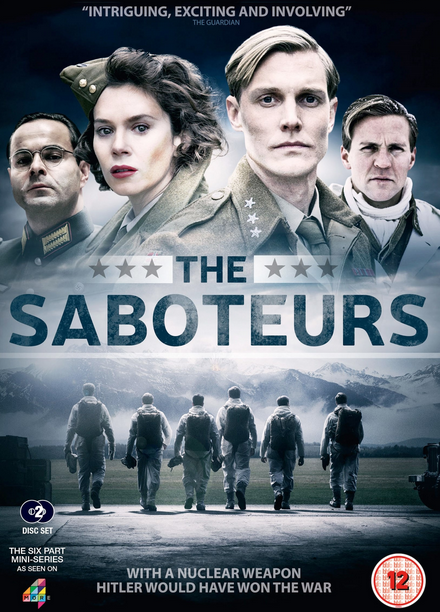‘The Saboteurs’: Stopping Hitler’s Atomic Bomb Joe Dolce
https://quadrant.org.au/magazine/2022/01/the-saboteurs-stopping-hitlers-atomic-bomb/
The six-part television series The Saboteurs (2015, originally titled Kampen om Tungtvannet, “The Heavy Water War”) was directed by Per-Olav Sørensen, written by Petter S. Rosenlund and produced by the Norwegian Broadcasting Corporation. The story focuses on the Nazis’ efforts to develop an atomic bomb during the Second World War and how they were foiled by a small group of Norwegian resistance fighters.
The series is told from four different perspectives: the German side, the Allies’ side, the saboteurs’ point of view, and that of Norsk Hydro, the plant ordered to produce the rare and essential component for the construction of an atomic weapon: heavy water, or deuterium oxide.
The series begins in Berlin in 1938. Hitler has been in control of Germany since 1933. Professor Werner Karl Heisenberg, recipient of the 1932 Nobel Prize in Physics, is invited to lecture at Columbia University but he refuses to leave Germany. He is visited by the SS and interrogated about his refusal to join the Nazi Party or participate in the 1938 Nuremberg Rally, and for quoting Jews, such as Max Born and Albert Einstein, in his research papers.
As a chastisement, he is ordered to report for army duty but a last-minute letter from Himmler (whose mother was a friend of Heisenberg’s mother) gains him an exemption from fighting because, as Himmler states, “Germany  needs its scientists.”
needs its scientists.”
Heisenberg is taken to the Waffenamt—the Army Weapons Agency—in Berlin, known informally as Uranverein, “the Uranium Club”. Their objective: to produce a nuclear reaction from uranium, towards the development of a super-bomb.
Heisenberg (right) explains, before an awestruck Germany military high command, that a single bomb containing one kilogram of enriched uranium can create an explosion equal to 10,000 tons of normal explosives. He receives a standing ovation.
The key ingredient required is heavy water, which can be most effectively produced at Norsk Hydro, a power station deep in the mountains of Norway. Heavy water is almost 11 per cent denser than ordinary water. This difference increases the strength of water’s hydrogen-oxygen bonds. If a heavy-water ice cube is dropped into a glass of ordinary water, it sinks. In 1939, the Germans order five tons of this specialised water—a slow process that will take Norsk Hydro almost three months to manufacture.
Germany invades Norway in 1940 and local resistance begins to mobilise. The German company I.G. Farben becomes part-owner of Norsk Hydro, and Bjørn Henriksen, a Norwegian German sympathiser, is appointed director.
Leif Tronstad, one of the pioneers in the research on heavy water, and a member of the Norwegian resistance, escapes to England to warn the Allies about the Nazi commitment to create an atomic weapon. He is assigned to Captain Julie Smith, the intelligence expert for Norway, and they are sent to Scotland, with Special Operations  Executive Commander Colonel John Skinner Wilson, to oversee an Allied plan to destroy the heavy water plant.
Executive Commander Colonel John Skinner Wilson, to oversee an Allied plan to destroy the heavy water plant.
The mission, Operation Grouse, involves a small advance team of parachutists who will establish an observation base on the Hardanger Plateau just above the water plant, and a follow-up team of commandos, landing in gliders (Operation Freshman) to enter the plant and destroy it with explosives. In Britain and Scotland, Tronstad (left) recruits willing expatriate Norwegians, familiar with the rugged Norwegian mountain terrain, to comprise the teams.
Heisenberg attends a conference in Copenhagen, meeting secretly with Niels Bohr, the Danish physicist who was awarded the Nobel Prize in Physics in 1922. Bohr works with the British, and Heisenberg gives him a simple sketch of the Germans’ planned reactor. Bohr considers it and advises him to resign from the project.
The Grouse commandos parachute into the mountains but are fifty miles off course from their intended target and begin a long hike through deep snow to their rendezvous. The glider team departs a week later. Each soldier is given a cyanide suicide pill, in a protective rubber casing, in the event of capture.
Unexpected strong winds cause the gliders to crash and twenty-nine men are killed instantly. The Nazis execute the twelve survivors. The four men of the reconnaissance team of Operation Grouse are now alone on the mountain awaiting further instructions, with rations running out and unable to find any game to hunt.
In Scotland, the Americans argue for an immediate air strike on the factory but Tronstad assures them that the seven floors of concrete above the heavy-water facilities in the lower basement will act as an effective buffer. A new plan, Operation Gunnerside, is developed to parachute another team of commandos to meet up with the four-member team on the mountain. The jump is successful and the two groups initiate their assault on the plant.
Under cover of night, the commandos covertly enter the facility, descending to the heavy water manufacturing area in the basement level. Explosives are secured to the tanks, with a short thirty-second fuse. A successful detonation destroys the cells and the 200 kilograms of heavy water in the storage tanks. The team escapes without casualties.
At this stage of the war the German army has lost 200,000 men in their failed Russian campaign and the director of the hydro plant is concerned that the Nazis may lose the war. Americans planes bomb a second Norsk Hydro factory at the Port of Herøya, and aerial photographs indicate the Germans are rebuilding the damaged heavy water plant. The American air force launches a massive bombing strike on the entire surrounding valley, killing twenty-one people, but the heavy water facility, secure in the lower level, as Tronstad warned, remains untouched.
The Nazis now make plans to move the factory to Germany by train, requiring them to transport the heavy water materials on the local passenger ferry across Lake Tinnsjø. The Allies devise a plan to sink the ferry but moral concern is expressed about the fifty innocent Norwegian ferry passengers, including elderly people and children, who will die in the blast. Justification for the sinking is argued as a “necessary cost of war”, with a recollection of the recent Nazi bombing of London—200 bombs a night for nine months, resulting in 43,381 dead, 50,856 seriously injured and 1,150,000 homes destroyed.

The plan is approved and Lieutenant-Colonel Knut Haukelid and two local men row out to the ferry in the dark, enter the lower hull and set the explosives with an alarm-clock timer. In the morning, the ferry departs the dock and at 10.45 the bomb detonates, sinking it in the middle of the lake. Eighteen local people are killed, including four Germans.
Churchill sends his congratulations to Colonel Wilson and the team in Scotland, and Tronstad is reassigned back to Norway where he hopes to reunite with his wife. But he is shot and killed by a Norwegian Nazi collaborator and never sees his family again.
Heisenberg is arrested by the Allies and interrogated by MI6, but is allowed to return to his family in Germany where he is permitted to continue working as a scientist.
There have been two previous films on these important missions: the first, with the same Norwegian title, Kampen om tungtvannet (1948), was directed by Jean Dreville. More of a docudrama, it featured four of the actual saboteurs playing themselves. Although it is considered one of the most important Norwegian films ever made, and was the second most popular film in France in 1948, the acting is amateurish and the film is neither as informative or as rewarding to watch as the 2015 series.
The Heroes of Telemark (1965) was directed by Anthony Mann, with script collaboration (uncredited) by Harold Pinter and starring Kirk Douglas and Richard Harris. With German accents bordering on comical, the first twenty minutes of the film is constructed like the typical Hollywood thriller of the day. Boulders are rolled down hills, smashing into a convoy of Nazi trucks, and Kirk Douglas, even though his character is a physics professor, manages to shoot a Nazi and hang precariously off a ship to push a mine away with a long pole. Nazis on skis chase the resistance fighters in the style of the James Bond films popular at the time. All of the original commandos’ names have been fictionalised, and the two well-known Hollywood actors in the lead roles give the impression that the story is about America, not Norway.
There is also a moral conflict in the ending, with the sinking of the ferry rewritten in true Hollywood fashion. The deaths of the innocent Norwegian civilians, including children, who will be collateral damage in the ferry explosion, are prevented by Kirk Douglas going back onto the boat after the charges have been laid to organise a “children’s game” which will get them all into lifejackets and down to the safe end of the ferry. After the explosion, Douglas stays on board to help them onto a lifeboat to safety before the ferry sinks.

But in the series, and in real events, there was no attempt to save or even warn the passengers. Fourteen civilians—those closest to the blast centre—lost their lives.
Leif Tronstad was a key figure in the building of the heavy water plant for Norsk Hydro and so had specialised knowledge on how to destroy it. He also was instrumental in gaining advance knowledge on the Nazi V-2 rocket from his associates in Germany. He was killed five months after his return to Norway.
Werner Heisenberg, winner of the Nobel Prize in Physics for the creation of quantum mechanics, was appointed director of the Kaiser Wilhelm Institute for Physics after the war.
The director of the water plant, Bjørn Henriksen, is a fictional character created from three real directors of Norsk Hydro. In reality Colonel Wilson did the work credited to “Julie Smith”, as there were no women in command roles in the British army.
Skis Against the Atom (1973) is a detailed memoir written by one of the operation commandos, Lieutenant-Colonel Knut Haukelid. Haukelid was born in New York and educated in Oslo. He was originally part of Operation Grouse, but had to drop out due to a shooting accident. In his book, he writes: “During a field exercise, I stumbled with a loaded pistol in my hand and put a bullet through the sole of my foot.”
In the series, this shooting occurs in the barracks when Haukelid and other members of Grouse are fooling around, seeing who can dismantle a sten gun the fastest. Haukelid is twirling his pistol, cowboy-style, and it goes off. He is left behind to recuperate.
Haukelid was a key part of Operation Gunnerside, the second team that parachuted in and destroyed the water plant. All nine commandos escaped. He recalled, “In the end, there was just a tiny insignificant pop. Is this what we had come 2,000 kilometres for? Sure, the windows broke, and there was a flash of light in the night, but it wasn’t much.”
 He remained in the mountains as a resistance fighter and led the operation that sank the ferry. He wrote that two alarm clocks were used to detonate the explosives, in the event the first one failed.
He remained in the mountains as a resistance fighter and led the operation that sank the ferry. He wrote that two alarm clocks were used to detonate the explosives, in the event the first one failed.
Many in the mission were conflicted about blowing up a Norwegian passenger ferry, but Haukelid had full authority to make the decision and he said regretfully, “An act of war [had] to be carried out which must endanger the lives of a number of our own people—who were not soldiers.”
Haukelid received Norway’s highest decoration for military gallantry, the War Cross with Sword, twice, in 1944 and 1947.
There are remarkably few reviews in English about this important and outstanding series. But it is not hard to imagine how Hitler might have used the bomb had the Nazis been first to develop it. Amy West wrote in the International Business Times:
Like the tagline of the show suggests: “With a nuclear weapon, [Hitler] would have won the war” and yet this piece of Scandinavian history is often forgotten. Often war movies or series concentrate on the grand scale of the conflict, rather than the genuinely thrilling and the monumental but small actions that took place throughout the years it spanned. By concentrating on a small part of the Second World War’s history rather than the entire thing, The Saboteurs allows itself to stylistically and effectively execute the history without overloading the audience with over-the-top heroism and far-fetched storylines, whilst also shedding some light on operations that really should be more widely remembered.
Norsk Hydro is presently one of the largest aluminium companies in the world, merging in 2009 with Statoil, and changing its name to Equinor. The state of Norway owns 34 per cent of the company. It’s rumoured that Norsk Hydro started producing heavy water after one of their engineers used some of the water, created as a by-product of ammonia production, to make himself a cup of coffee and noticed that it boiled at a slightly higher temperature than ordinary water.
To the Norwegian resistance fighters, heavy water was a mysterious substance that hardly anyone understood, but they were prepared to risk their lives to keep it out of German hands. Today, Argentina and India are the world’s largest producers of heavy water. Iran is third on the list.
I.G. Farben was formed in 1925 from a merger of six German chemical and pharmaceutical companies, including BASF, Bayer, Hoechst and Agfa, and was once the largest conglomerate in Europe. Three company scientists were Nobel Prize winners. The company is infamous for using concentration-camp slave labour during the Second World War and creating Zyklon-B, the cyanide-based pesticide that was used in the gas chambers of Auschwitz and Majdanek. Twenty-three directors were tried for war crimes at Nuremberg. I.G. Farben was split up in 1951, back into its six original companies.
The first atomic bomb was dropped on the city of Hiroshima, Japan, in 1945, and killed 140,000 people immediately, rising to 192,000 deaths from radiation-based diseases over the next fifty years. When the first H-bomb was exploded in 1952, a new chemical element was synthesised, named einsteinium, in honour of the discoverer of the atom.
Einstein wrote to President Roosevelt as early as 1939 about the possibility of creating a single atomic bomb that could demolish an entire city. In 1940 he warned about the work progressing to that end in Nazi Germany.
Although he is commonly associated with the bomb, Einstein did not work on the US Manhattan Project that developed it. He once said, “If I had known that the Germans would not succeed in constructing the bomb, I would never have lifted a finger.” He spent the rest of his life as a peace activist, protesting against the use of atomic energy for weapons of war.
The Saboteurs is a beautifully filmed period piece that focuses on one of the most crucial, but little known, missions of the Second World War. Amy West says, “If you’re a military enthusiast, or find yourself poring over war documentaries and history books enthusiastically, then this is a series you absolutely must not pass by.” You will be hooked from the start with the stunning collage of colourised archival Nazi footage and evocative soundtrack over the opening credits. The rest of the series maintains the high standard.
Comments are closed.
